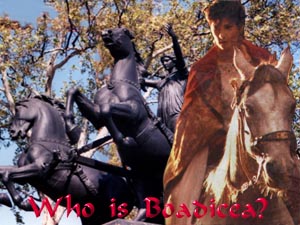 |
 |
How I discovered BoadiceaI use the nickname of Boadicea to represent myself, but who is this character? This small page will, I hope, help you discover who the Killer Queen was.
This was how I discovered the character of Boadicea, thanks to Enya's song of the same name. You are listening to a MIDI version of this song right now, that was sequenced by Jeremy Ho (other MIDIs can be found at Angeles). But this is but a short summary, compared to all the legends on Boadicea. Boadicea is in fact Boudicca, the former name was given to her later, when it was stylised (personnally, I prefer Boadicea to Boudicca). She was considered as a model of courage for the Britons (ancient inhabitants of Great Britain) as she dared to defy the powerful Romans for freedom. Here you shall find a summary of her life and actions. I cannot say that this is the exact and entire truth, simply because the only texts we have come from the Romans, and we know that the Roman historians used to exaggerate the foe's faults in order to glorify themselves, as historians still do to this day, when speaking of recent history. Boadicea's LifeJulius Caesar had started Britain's invasion in 55 B.C., but never really managed to impose his domination over the Britons. It was in 43 A.D. that the Emperor Claudius ordered that Britain should be conquered. It is during this second invasion that Boadicea's story is set. Boadicea was described as a fearsome, powerful woman. This description comes from a Roman writer:
Boadicea was married to Prasutagus, the King of the Iceni tribe in East Anglia, and they had two daughters. Prasutagus was a rather weak king, and to avoid a war he made a pact saying that all his lands and riches would be split between his daughters and the Romans at his death. When he died, the Romans plundered the Iceni houses and invaded the entire land. They also flogged Queen Boadicea. This provoked the her anger. She started up a great rebellion, capturing the town of Camulodunum (Colchester), then marched onto Londinium (London) and Verulamium (St Albans).
Boadicea managed to frighten many Romans, yet they were powerful and well organised, unlike the Britons. An army of 10'000 Romans was prepared to counter Boadicea's 100'000 men horde. It is said that she held this speech to them before the battle:
It is well known that the Romans are very organised. Their men managed to vanquish the Britons, and they finally captured Boadicea. Rather than undergo another humiliation from the Romans, according to Roman historian Tacitus, she took poison and died. Another version of the story, by Cassius Dio, says that Boadicea died in her cell, of a disease.
Why choose Boadicea as a nickname?I believe that Boadicea, along with other Celtic rebels such as Vercingetorix and later William Wallace, are examples of courage and pride, that should be followed. Maybe that they lost their battle and died, yet they stood up to the crushing authority and wanted to fight for their people and land. But Boadicea is also one of the rare women who fought violently for justice. This is also to show that women may be as powerful and brave as men, maybe sometimes even more. Boadicea represents the rebellion of a wronged people, the power of the Celts, the pride and will of a brave woman and the great fear that the ancient Britons could cause for the Romans. This is why I proudly bear her name, as a remembrance of a great Queen. In no way is this page meant to promote racist or xenophobic thoughts about the Romans' descendants or to show the Britons' superiority over other races. I only mean to show some people that the Celts were also honourable and powerful. |

Main Site | Saint Seiya | Enya | About the author | E-mail Boadicea
All Saint Seiya images, plotlines and sounds are ⌐ Masami Kurumada, Toei
Productions (anime), Shonen Jump (manga) and Seiji Yokoyama (music).
Fanfictions (except where specified), web creation and articles by Viviane Reber. All
rights reserved.